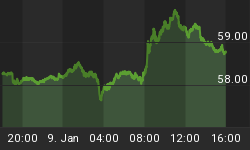Below is an extract from a commentary originally posted at www.speculative-investor.com on 26th October, 2008.
Current Monetary Situation
The first of the following charts shows that the year-over-year percentage change in the US Adjusted Monetary Base (AMB) has taken off like a rocket over the past few weeks. The AMB is comprised of currency in circulation (Federal Reserve notes) and bank reserves.
The second of the following charts shows that the year-over-year percentage change in US M2 money supply has recently experienced a significant increase; however, the increase in M2's rate of growth is small relative to the increase in AMB's rate of growth.
These charts tell us that a) the Fed has begun to inflate as if there were no tomorrow, and b) the Fed's efforts have not yet had a dramatic effect on the economy's total money supply.


The main reason for the difference between the recent performances of AMB and M2 is that there has been a massive (almost $300B) increase in bank reserves. Banks have taken full advantage of the Fed's largesse and have substantially increased their reserves, but bank reserves are not included in broader measures of money supply.
Banks will eventually inject their excess reserves into the economy by making new loans, thus transforming the increase in reserves into an increase in total money supply. But there is the risk that "eventually" will prove to be a very long time and that over the coming months/quarters the banks will frustrate the Fed's inflation-promoting efforts by continuing to build up reserves. To get around this potential problem the Fed plans to inject money directly into the economy (it is going to bypass the banks). This will be done via the Commercial Paper Funding Facility (CPFF), which was announced a couple of weeks ago and will go into operation this Monday, and the Money Market Investor Funding Facility (MMIFF) that was announced last week. These facilities will allow the Fed to inject hundreds of billions of dollars, or trillions of dollars if need be, directly into the economy.
As we've noted in earlier commentaries, in order to set the stage for an eventual inflationary outcome the Fed does not have to create enough new money to offset investment losses and the economy-wide reduction in credit. Credit contraction will usually put downward pressure on the prices of commodities and assets in the short-term, but it doesn't directly affect the money supply and therefore doesn't directly affect the long-term trend in money purchasing power. Credit contraction can LEAD to a reduction in the supply of money and can therefore have an indirect effect on the long-term trend in money purchasing power, but if the money supply continues to increase it means that the Fed's actions are counteracting this indirect effect.
Inflation Expectations
A few months ago the inflation threat was front-page news. People at that time were very concerned about the rising cost of living because the outward effects of inflation had become so blatant that even the US Government's heavily massaged numbers had begun to scream "inflation problem". However, it was at this time that we began to discuss the likelihood of a DEFLATION scare. Our view was that the relatively slow money-supply growth of 2005-2007 would lead to lower equity and commodity prices and, eventually, to the fear of deflation superceding the fear of inflation. Also, we thought it would be a deflation SCARE rather than genuine deflation (money-supply contraction). This is because we expected that central banks and governments would ramp up their lending/borrowing in response to the changing situation.
We have therefore not been surprised to see the emergence of a deflation scare. What has surprised us is the incredible speed with which the general perception has shifted from fear of inflation to fear of deflation. The suddenness of the change is illustrated by the following Fullermoney.com chart of the "Expected CPI" (the difference between the 10-year T-Note yield and the 10-year TIPS yield). This chart reflects one the fastest declines ever in inflation expectations.

Despite what some Federal Reserve researchers happen to believe, inflation expectations have plunged. Moreover, the plunge in inflation expectations translates into a surge in real interest rates because the real interest rate is the nominal interest rate minus the expected rate of currency depreciation. This increase in real interest rates adds to the upward pressure on the US$ and the downward pressure on asset prices. There's actually a self-reinforcing trend at work in that falling prices lead to lower inflation expectations, which lead to higher real interest rates, which add to the downward pressure on asset prices, and so on.
We aren't offering a free trial subscription at this time, but free samples of our work (excerpts from our regular commentaries) can be viewed at: http://www.speculative-investor.com/new/freesamples.html.















